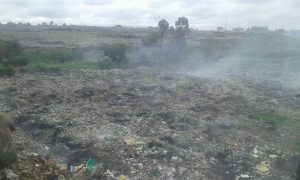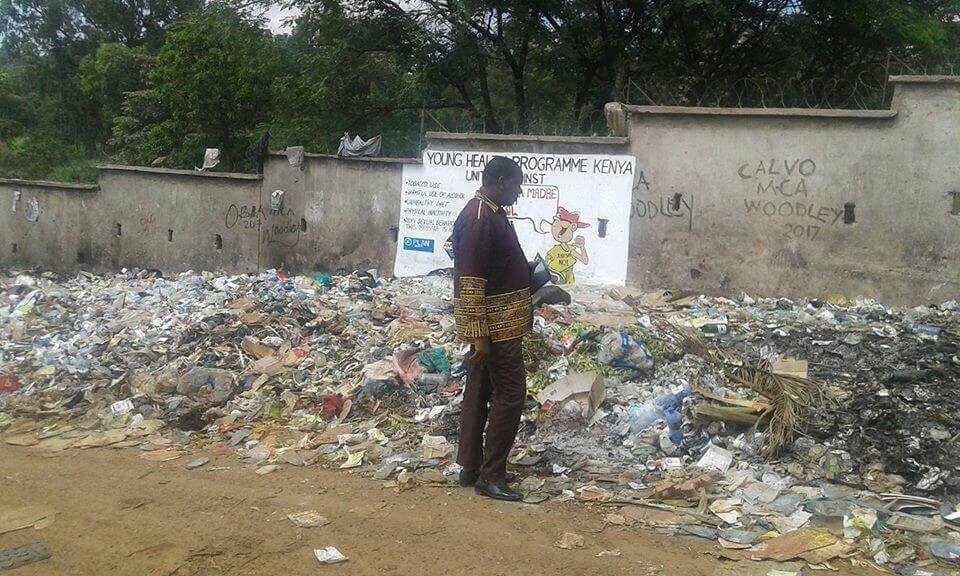Dandora is the biggest dumpsite in Nairobi, an estate littered with dirt and overflowing sewers pouring into the drainage system. For most though, it is the high level of crime, thanks to the jobless youth, who idle in the area, youth who strike fear in residents, even in broad daylight. Prof. Jared, an environmentalist, tells us about the cesspool of crime and disease. A Different Truths exclusive.
 Kenya’s Dandora city dump site is the only dumping location for waste in Nairobi, East Africa’s most populous city, and serves as a provocative starting point for understanding the growing health, poverty and sanitation problems facing the rapidly expanding capital and region.
Kenya’s Dandora city dump site is the only dumping location for waste in Nairobi, East Africa’s most populous city, and serves as a provocative starting point for understanding the growing health, poverty and sanitation problems facing the rapidly expanding capital and region.
When the name Dandora is mentioned what comes to mind for many, this estate in Eastlands, located on the outskirts of Nairobi, infamous for being dirty, a lucrative den for pickpockets, not to mention a place you can easily meet your death.
Others associate Dandora with the biggest dumpsite in the country, an estate littered with dirt and overflowing sewers pouring into the drainage system.
For most though, it is the high level of crime, thanks to the jobless youth, who idle in the area, youth who strike fear in residents, even in broad daylight.
Dandora dumpsite is a lifeline for hundreds of people who rummage through the waste in search of valuables.
Dandora dumpsite is a lifeline for hundreds of people who rummage through the waste in search of valuables.
Smelly and rotten waste is the order of the day, but this does not scare the men, women and children who flock there every day.
And when darkness pushes them out of the landfill, some burrow themselves into the waste to endure eerie, lonely and risky nights besides vagaries of weather.
And when darkness pushes them out of the landfill, some burrow themselves into the waste to endure eerie, lonely and risky nights besides vagaries of weather. No regular showers, food or friends, save for Marabou Storks, stray dogs and pigs.
They have witnessed rival groups slaughter each other over control of the landfill, guns and dead bodies being hidden there and police versus gangsters’ gunfight spill to the dumpsite.
The garbage from the city of Nairobi is dumped into a mountain of decaying waste and sewage that sprawls some 5 km and is controlled by Nairobi’s most notorious clan of thugs.
The garbage from the city of Nairobi is dumped into a mountain of decaying waste and sewage that sprawls some 5 km and is controlled by Nairobi’s most notorious clan of thugs.
Desperate people, children included, risk their lives rummaging through this butchered heap of unwanted material. There’s no rubbish separation when it comes to Dandora, bloody medical debris mixes with other waste, creating a hazardous area where poison is visible to the eye.
Nairobi River, runs along the side of the dump carrying with it the venom from rotting garbage as well as frightening run-off liquid.
There’s an unmistakable stench like a fog of death blanketing the air when arriving to the Nairobi dump site. Nairobi River, runs along the side of the dump carrying with it the venom from rotting garbage as well as frightening run-off liquid.
The gangsters who control the dump hibernate, hiding in the heaps of garbage by day and counting their treasures. When night falls, the thugs come out of their hiding, back to their homes and families or else out to cause trouble.
The country’s leadership has long shown alarming indifference to Dandora – ignoring environmental laws, UN-commissioned health studies, and calls for closure from human rights groups.
The country’s leadership has long shown alarming indifference to Dandora – ignoring environmental laws, UN-commissioned health studies, and calls for closure from human rights groups. A contested February 2012 process to decommission the site was recently canceled. Through a narrative of survival amidst tragic health and environmental consequences, this project explores a marginalised population long overshadowed by an industrializing city’s expansion.
Any mention of solid waste in cities such as Nairobi conjures up images of huge heaps of garbage. It’s an eyesore many residents want eliminated.
In Dandora, however, thousands of slum dwellers try to earn a living out of the dumpsite by collecting electronics, meat bones, metals, milk bags, plastics and rubber, which are mostly sought after for recycling.
In Dandora, however, thousands of slum dwellers try to earn a living out of the dumpsite by collecting electronics, meat bones, metals, milk bags, plastics and rubber, which are mostly sought after for recycling.
But as they do so, hazardous waste, such as used syringes, endanger the lives of those rummaging through the filth. This is because all manner of garbage from airports, hotels, industries, residential areas and restaurants is dumped there.
For instance, a study commissioned by the UN Environmental Programme, in 2007, revealed that soil samples collected from the site recorded high levels of lead compared with reference standards in the Netherlands and Taiwan.
Studies done have pointed health effects due to the presence of hazardous  elements, such as cadmium, lead and mercury. For instance, a study commissioned by the UN Environmental Programme, in 2007, revealed that soil samples collected from the site recorded high levels of lead compared with reference standards in the Netherlands and Taiwan.
elements, such as cadmium, lead and mercury. For instance, a study commissioned by the UN Environmental Programme, in 2007, revealed that soil samples collected from the site recorded high levels of lead compared with reference standards in the Netherlands and Taiwan.
Similar findings were reported for other heavy metals. Tests carried out on 328 children and adolescents living and attending school near the dumpsite indicated a significant health impact, with 154 suffering respiratory problems.
Over the last three decades, the public health impacts of environmental pollution, in particular the burden of disease, have raised increasing concern globally.
The study sought to emphasise the link between environmental pollution and public health in an urban setting. Over the last three decades, the public health impacts of environmental pollution, in particular the burden of disease, have raised increasing concern globally.
Mercury is listed by the World Health Organisation as one of the top 10 most harmful chemicals. Exposure to it, even small amounts, can cause serious health problems. These include destruction of the nervous system, digestive and immune systems, the lungs, kidneys, skin and eyes. Batteries, switches, cosmetics, soaps, creams and pesticides are some of the products that contain mercury.
About a quarter of the diseases humans face today, WHO estimates, occur due to prolonged exposure to environmental pollution.
About a quarter of the diseases humans face today, WHO estimates, occur due to prolonged exposure to environmental pollution. Most of them are not easily detected. They are acquired during childhood and manifest themselves later in adulthood.
Once the Dandora dumpsite if full which of course is, the inhabitants of Dandora needs to decide and find a new dumpsite. Before the garbage is dumped in the dumpsite, they should separate the garbage into recyclable products, biodegradable products and non-biodegradable products. The recyclable products should be separated and be taken to recycling plants, the biodegradable should be kept together to form a massive compost heap and the non-recyclable or biodegradable products should be burnt in an incinerator and this way the dumpsite will be cleared and the amount of air pollution will be much more less. The government should also be able to provide workshops for the illiterate and teach them how to look after the environment and their own personal health. The government should also sensitise the inhabitants about the mental, physical, and health effects of the dumpsite. By doing this more jobs will be provided which leads to an economic growth.
©Prof. Jared Akama Onyari
Photos by Francis Onyiego Nyagaka





 By
By
 By
By
 By
By
It is a concerning issue as far as environment is concerned. But Author has suggested the solutions quite skillfully and should be taken into consideration by the concerned authorities.